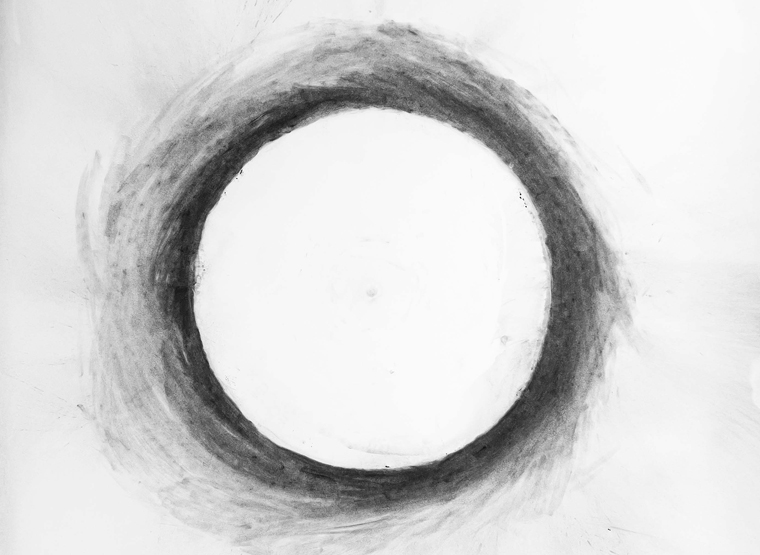
Untitled: (Ice Vinyl) Charcoal on Stonehenge paper, Alberto Checa (photo courtesy of Oolite Arts)
Art reviews start with a shard of light from Miami’s cornucopia of selections before layers of the proverbial onion start unfurling. Concepts, books, movements in art, politics, religion, et al, pop up as I dig into the influential aspects of the artist’s output.
By the time I’ve gone down several rabbit holes, a basic review becomes a hallway of doors opening, ideas generated.
I do not always immediately see why exhibitions are going to hook me until I know what I’m dealing with. If you don’t open the book, how can you tell what lies between the pages? Artists spend time on their work; time for thoughts to gel…new abstractions to consider as an epiphany develops in its own time frame.
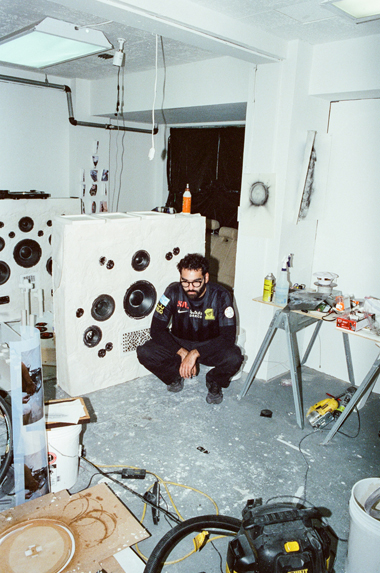
Artist Alberto Checa (Photo courtesy of the artist).
Miami’s long respected gallery, Oolite Arts on Lincoln Road, opens a new portal via a first solo exhibition by Cuban multidisciplinary artist Alberto Checa.
“Amidst Twin Suns” is curated by Jean Chung, an independent writer, and long-time colleague of Checa, co-ordinating the artist’s drawings and installations with continuous performances, weaving insights and thoughts of his childhood in Cuba, his immigration story and impressions of American labor. Chung’s practice stems from a diaristic approach that includes repetition and the constant translation between photo, painting and text.
Checa’s mother and her experience coming into America’s difficult immigrant labor pool was extremely influential in the artist’s work. Checa is a maintenance worker on boats. “Amidst Twin Suns” reflects his life, balanced between a labor job, segueing to an intense love of his art, family, and nights in his studio as a resident artist at Oolite.
This exhibition is “a communication between the drawings, imprints, from materials in the show,” according to Checa. Some are typical drawings of certain structures shown at Oolite. Mainly the work is imprints of sound on paper …that use “the air that comes out of the speaker.” He’s using materials that go unseen in the work with air and sound.
I looked to curator Jean Chung for greater insight.
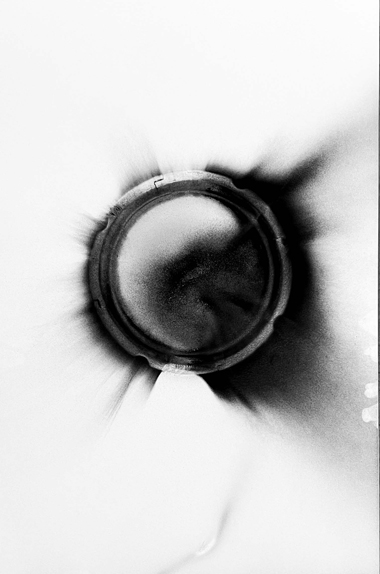
Untitled (Xtasis), Albert Checa (Photo courtesy of Oolite Arts)
Irene Sperber: How did you approach communicating Checa's most important message?
Jean Chung: “Though Alberto and (my) art practices have always been very different (he works largely in performance and sculpture while I do in writing and painting) we approach the process of creating in similar ways — through cataloging and rearranging. This approach is not only an intrinsic way for us to tell a story, a way to reach out to the world, but it in itself becomes an internal record, a way for us to reference things . . . I like to think of it as a sort of constellation, where there are so many dots to connect in so many different ways to make sense of something. Sometimes the same dot is connected in different ways, or conjoined, or sometimes they disappear altogether. But nothing really has a finite destiny.”
IS Tell me how the added opening night collaborative performance with artist Nick León underlines the thoughts in this show? (León is an experimental electronic musician living in Miami)
JC: “Alberto often speaks of sound and music in the workplace being a driving force of labor. It is an act of care in moments of physical endurance and also something that is deeply rooted in his own experiences. This relationship between song and labor is something that is found across cultures too, song as something soothing, something collaborative, something to distract from . . . There’s a Korean lineage of this too called ”Nodong-yo” which literally translates to work song.”
IS: Art has a way of driving its own end result. Did you learn anything surprising when the exhibition was being organized?
JC: “I think at every corner was something unexpected, and not in a bad way because neither of us approached this exhibition from a top-down place of having a conclusive idea of what it was going to look like . . . I think we’re both proud and thankful of the presentation.”
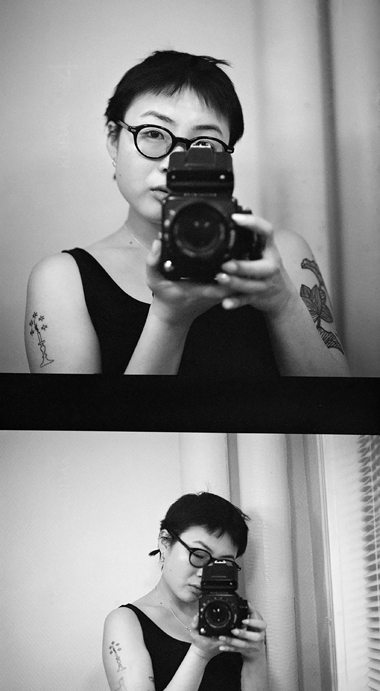
Curator Jean Chung (photo courtesy of Jean Chung).
We also spoke to Checa about his work.
IS: Does the quiet focus of physical movement as a boat maintenance worker give time to contemplate on a deeper level with this integral messenger (the boat) of the immigrant experience?
AC: “During my shifts working on the boat, the immigrant experience is not something I persistently contemplate. However, from the repetitive physical movement arises a trance-like focus where I usually meditate on my practice. The movements involved in waxing fiberglass, polishing metals, cleaning bilges and all the various meticulous tasks that are demanded from me in order to upkeep the vessel become almost like choreography to the body while my mind becomes a tool for my practice . . .
"During scorching days or days spent away from the studio, my body tends to become machine-like, while my mind becomes a sketchbook. Unremarkably, this choreography and introspection has become a skill for survival as it is not an ideal situation, but instead is about working and assimilating with my environment and circumstances . . .
“That being said, the immigrant experience is about the community built around labor, the relationships cultivated, and the strive to overcome what’s next. The actual boat is just a catalyst for community. Frankly, not much thought goes into the fact that we are all immigrants working on a boat - and if it arises, it is simply banter, that is the beauty of it."
IS: Is there a specific piece that refers to your mother’s experience with back breaking work translated to ideas shared as an artist?
AC: “My mother is my inspiration and the reason I began making art in the first place as a way to empathize with her while I was dependent (on her sacrifice). There is no specific piece that is in reference to her, yet at the same time they all are. There are key elements that act as a vocabulary for my work through repetition that directly reference the spinal cord and parts of the body . . . I emphasize on documenting the figures in my work from the back, This is in direct conversation with injuries while remaining subtle in the way they are translated.”
I asked about his usage of the word “meaningless” in regard to manual labor. I wondered if the work did have “worth,” despite the obvious human exploitation of the workers.
“You cannot give meaning to work when health is not prioritized and the conditions to perform are not regulated. The product becomes a priority and is given more meaning than the self. There is no meaning to the work when you are working to survive," he says. "The peaceful, gentle life has come to an end. Speed has become a constant in the life of mankind. Lucio Fontana speaks about this in 'The White Manifesto.' While he is talking about the change in (the) way man is responding to art, there is a lot that can be unpacked there in relationship to the act of ‘making’ in general . . . We are living in a time where the immigrants cannot afford rest, especially in Miami where we are living through a housing crisis. Can one afford to produce meaningful work when trying to make ends meet in order to survive?”
IS: In the show's title, the Twin Suns would also indicate two shadows…does that idea of double darkness (or shadow self) factor into your work at all?
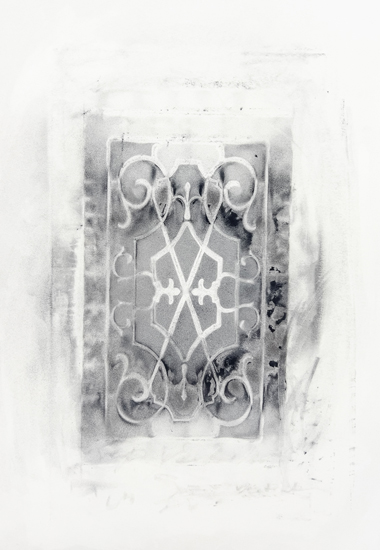
Untitled (Vent), Alberto Checa (Photo courtesy of Oolite Arts)
AC: “The idea of Twin Suns stems from the reflection of the sun on the horizon onto thE the water, so it doesn’t necessarily cast a double shadow, rather, it causes double the heat. The idea of the shadow in my work is seen through the negatives of an imprint. In preparation for the exhibition, I would write all of the things that began to create imprints on my body — the chain around my neck, sandals on my feet, the long sleeve mark on my wrists, the tan around my eyes due to my glasses, etc. The idea of the shadow is very protective in a way. We tend to always seek different places to sit and rest away from the sun, almost always in a place with shadow. The drawings for the exhibition and the cyanotypes are in conversation with the shadow and the idea of the remains, marks, archiving, in some sort of way.”
Alberto Checa was guided by Arte Povera, a radical Italian art movement (1960s/1970) utilizing unconventional processes and non-traditional materials of daily life. Post-minimalism is closest to the U.S. version. The Cuban book "Con Nuestros Propios Esfuerzos (With Our Own Efforts") influenced Checa’s work. The Cuban government controlled the way household objects could be repurposed after the fall of the Soviet Union, during El Periodo Especial en Tiempo de Paz (Special Period in Times of Peace). Checa constructs sculptures using PVC pipes, plaster, silicone molds, water vacuums, sounds. Especially thoughtful is his usage of sound waves pulsing from stereo speakers creating some of the images seen in this show. Mobilized by sound, the artist will be mixing, pouring, and molding plaster, using a network of PVC structures and hoses to complicate the labor process.
Definition of the word Oolite: “A type of sedimentary rock, usually limestone, made up of ooids cemented together. An ooid is a small spherical grain that forms when a particle of sand or other nucleus is coated with concentric layers of calcite or other minerals. Ooids most often form in shallow, wave-agitated marine water."
I’m seeing I can draw a line from the meaning of the Oolite particle to the gallery’s current exhibition referencing water playing a part in formation of new entities, separate particles connecting, becoming one. Making connections in society, in ideas, in the working of the universe is endlessly exhilarating. We all come into this world with a different perspective, enjoy ideas Oolite can bring via topics they choose to celebrate.
"Amidst Twin Suns," opens Wednesday, Feb. 7 with a reception from 6 to 9 p.m. Exhibition on view until April 14. Oolite Arts, 924 Lincoln Road, Miami Beach, 33139. Regular hours daily noon to 5 p.m. www.oolitearts.org or call (305) 674-8278.
 MAIN MENU
MAIN MENU

